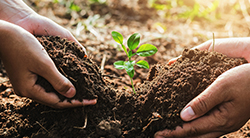 In Parashat Acharei Mot, we read:
In Parashat Acharei Mot, we read:
"You must keep My laws and My rules, you must not do any of those abhorrent things, neither the citizen nor the stranger who resides among you; for all those abhorrent things were done by the people who were in the land before and the land became defiled. So let not the land vomit you out for defiling it, as it spewed out the nation that came before you." (Lev. 18:26-28).
There are many elements that mark the spiritual mindset. Biblically, it is a perception of connection: divinity to humanity, cause to effect, blessing to virtue, and struggle to sin. Much of this ancient lens runs counter to modernity, in which humanity is seen as separate from beast and earth. In Torah, we see rain as relationship, an earth woven with ethic. Blessing is felt through pastoral plentitude, punishment through agricultural atrophy. The priestly precision of Leviticus imagines an ecology in which human morality determines terrestrial harmony. In Parashat Acharei Mot, we are deluged again with detail, ranging from priestly rites to sexual ethics, unified in conveying the sense that such laws guide us towards cosmic harmony.
Just as any being, when faced with disease and the invasion of something incompatible, will vomit out the offensive element, so too will the Land. For Leviticus, divine law is natural law: in adhering to one, the other is fulfilled. Conversely, violation of such law results in a punishment of both deity and dirt.
For some, we read such stricture as irrelevant or offensive; for others, we may see them as reflections of a worldview both primitive and simplistic. Today, few see the rise and fall of nations as a reflection of ritual accuracy or natural disaster as correlated to carnal choices. But the mindset of a perception of connection is one that we return to in a 21st-century definition of ecology. We are now aware of the immense complexities of our ecosystem: polar melts link to a polar vortex, hurricanes lead to migratory shifts that alter crop fertility. We are, more than ever in modernity, aware of our human impact on a global scale, and conscious of a connectedness to which we are subject.
Many of our early Sages, though living in an era without Temple or priestly performance, maintained this biblical ecology. In a midrash on Creation, we read:
"Look at God's work – for who can straighten what He has twisted?" (Kohelet 7:13). When the Blessed Holy One created the first human, He took him and led him round all the trees of the Garden of Eden and said to him: “Look at My works, how beautiful and praiseworthy they are! And all that I have created, it was for you that I created it. Pay attention that you do not corrupt and destroy My world: if you corrupt it, there is no one to repair it after you." (Kohelet Rabbah 7:13)
The state of earth and environment is a reflection of human ethic; so too, our treatment and stewardship of the world mean to mirror the height of humanity. The concept is further expanded in the Babylonian Talmud not only to any wanton destruction (Kiddushin 32a), but also to any kind of waste (B’rachot 52b) and even to over-ostentation and over- indulgence (Chulin 7b; Shabbat 140b).
For many of the Chasidic masters, this same spiritual ecology also invites nature as a door to divinity. The late 18th-century rabbi, Nachman of Bratzlav, went so far as to believe that communing in nature was a necessary element of religious devotion. He wrote this prayer:
“Master of the universe, grant me the ability to be alone; that it may be my custom to go outdoors each day among the trees and the grass, among all growing things and there may I be alone to enter into prayer, to talk with the One I belong to. May I express everything in my heart and may all the foliage of the field – all grasses, trees and plants – may they all awake at my coming, to send the power of their life into the words of my prayer, so that my prayer and speech are made whole through the life and spirit of growing things, which are made as one by their transcendent Source. May they all be gathered into my prayer and thus may I be worthy to open my heart fully in prayer, supplication and holy speech.” (The Empty Chair [Woodstock, VT: Jewish Lights,1996], p. 86)
More than any other offering, perhaps our priestly precursors gift us today with the very mindset necessary for our own collective survival. In an age in which we see the collapse of ecosystems and rapid changes to climate and sea level, we are already seeing lands casting out their inhabitants. Rather than assuming such fates are both disconnected and beyond us, we inherit a spiritual tradition urging us towards a perception of connection. Such a frame offers a new ethic with ancient roots, one that invites us to see our each and every choice as woven into the very soil beneath us. Perhaps it is time to ditch the dialectic of disconnected dominion given by God in Eden (Gen. 1:26-28), and instead set our sights as global gardeners.
The medieval English anchoress, mystic, and author, Julian of Norwich, writes:
Be a gardener.
Dig a ditch
toil and sweat,
and turn the earth upside down
and seek deepness
and water the plants in time.
Continue this labor
and make sweet floods to run
and noble and abundant fruits to spring.
Take this food and drink
and carry it to God
as your true worship.
(Julian of Norwich)
Rabbi Ben Spratt is the senior associate rabbi of Congregation Rodeph Sholom in New York, NY. His passion continues to be building community beyond existent walls and boundaries and, in partnership with many others, has sparked Shireinu, Tribe, New Day Fellowship, and Minyan.

In the first two chapters of Acharei Mot, God gives Moses specific instructions to pass on to Aaron. These instructions clearly state that Aaron should not come, “at will, into the Shrine behind the curtain, in front of the cover that is upon the ark, lest he die;” (Lev. 16:2). These boundaries explained by God delineate when and how one is allowed to offer a sacrifice to God, surely provoking painful memories for Aaron, as his sons, Nadab and Abihu did exactly what God forbade, offering unsolicited “alien fire” on the altar that lead to their death. For a father in mourning, these boundaries also provided specific guidelines; perhaps a comforting structure that he needed at just this time.
The entire Book of Leviticus is an instructional manual for how one lives a holy life, described by clear boundaries for when and how one can be in relationship with God, with other human beings, and with our greater world. Rabbi Spratt’s teaching beautifully illumines our ethical and spiritual connection to our ecological environment, highlighting the structure that God put into place for which we are now caretakers.
As Rabbi Spratt teaches, “In an age in which we see the collapse of ecosystems and rapid changes to climate and sea level, we are already seeing lands casting out its inhabitants. Rather than assuming such fates are both disconnected and beyond us, we inherit a spiritual tradition urging us towards a perception of connection.”
That connection is certainly felt with our physical earth, and in Aaron’s case, within the boundaries set between him and God, and between his role as a priest for the community. God instructs Aaron to first offer his bull of purgation offering on behalf of himself and his family, and then he is allowed “behind the curtain” of the Ark. After his bull offerings he offers the first goat on behalf of the community and ultimately, he places the sins of the community on the goat of Azazel.
Imagine the huge responsibility of following this step-by-step process with the repetition of how the offerings are given. Imagine the comfort in knowing you are following God’s instructions exactly as God expressed them to Moses, and by doing so you are allowing an entire community to be in relationship with God, free of sin.
Structured, intentional boundaries in our environment and our relational world sometimes make us feel separate from our earth, from God, and from one another, but often, they bring us together. Our relationship with endangered animals, based on providing them with the physical space they need, while intervening when necessary speaks to this delicate balance. Our most intimate relationships with our spouses and children also illustrate the balance of being deeply enmeshed in one another’s lives while providing each other with the necessary space to grow and change.
Inspired by Aaron’s leadership, our communities recognize when these boundaries have broken down, and we repeat this ritual of repenting for our sins as a community, once a year on Yom Kippur (through prayer), coming closer together as a community and to God. Rather than casting out those who sinned, as God did with Nadab and Abihu, God now offers clear instructions for staying in relationship, with clear boundaries.
Rabbi Amy Cohen is the associate rabbi at Temple Beth Shalom, Austin, TX.
Acharei Mot II, Leviticus 18:1−30
The Torah: A Modern Commentary, pp. 877−888; Revised Edition, pp. 769–776
The Torah: A Women’s Commentary, pp. 688–700
Haftarah, Ezekiel 22:6-19
The Torah: A Modern Commentary, pp. 997−998; Revised Edition, pp. 795−796
